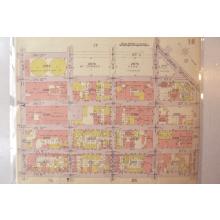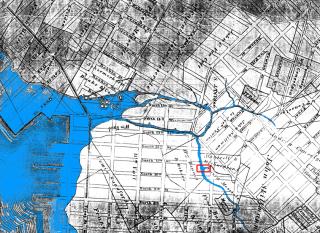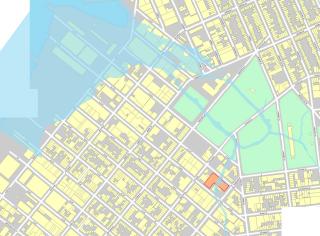Editor's note: This article was originally published by Brooklyn 11211 . It has been revised and updated with new information.
Gowanus Lounge has been all over the Roebling Oil field of late.1 One thing that intrigued me about the appearance of (purported) toxins ickiness at this site and across the street at the apartment building on the northwest corner or Roebling and North 11th2 was the fact that neither site appeared to have been home to the usual toxic soup of Williamsburg’s past. In fact, both sites seem to have housed pretty benign uses, as the 1929 map below shows.
So why the oil here? And what of Rob’s contention that the blocks to the southeast might be next? Turns out, he could be on to something; I was just looking at the wrong map.
Once upon a time, Williamsburg and Greenpoint were divided by a rather large creek and surrounding marshland - as seen below in an 1833 map of the Village of Williamsburgh. The creek was originally called Norman Kill, after one Dirck de Noorman, or Dirk the Norseman – the first European settler in this part of Brooklyn. Later renamed Bushwick Creek, this waterway was at one point navigable by boat as far inland as Grand and Rodney. Older maps show much of the area to the east of Union Avenue and throughout McCarren Park as marshes.3 As late as the 1830s, the only direct connection between Williamsburgh and Greenpoint at the waterfront was a long footbridge (seen below) connecting First Street (Kent Avenue) to Franklin Street. It was only in 1838 was a vehicular bridge constructed across Bushwick Creek. Prior to that, Greenpointers who didn't want to travel far inland had to use boats to travel to Williamsburgh.
Today, the little that’s left of Norman Kill is known as Bushwick inlet (see map #3, below). It is still the dividing line between Greenpoint and Williamsburg, its just not the barrier it once was.
So what does all this ancient history have to do with the discovery of oil on Roebling Street? Maybe nothing, but maybe this: a branch of Norman Kill runs directly beneath the Roebling Oil field site (outlined in red on maps #2 and #3). It also runs beneath the newish apartment building across North 11th Street to the north4, and beneath the block to the southeast that GL identified as another possible oil field site. This tributary, once known as Swede's Kill, is the part of Bushwick Creek that was navigable as far south as Grand and Rodney Streets.5
But Standard Oil had other operations in Williamsburgh and Greenpoint (Standard wasn’t a monopoly for nothing). Chief among these - and perhaps most significantly for the discussion at hand - was Charles Pratt’s Astral Oil refinery, which was located at the mouth of the Bushwick Inlet. Today, this is the Bayside Oil site – a site that is slated to become a public park, but which Parks has acknowledged is an environmental nightmare (understandable, considering that the site has been home to some form or another of petroleum processing for close to 150 years).
And, yes, if you look at maps #2 and #3, you will see that the Bayside/Astral site is right downstream from the Roebling Oil field.
But wait – oil can’t flow upstream, can it? Well, just as the East River is not a river (to us in Brooklyn, its not even East). The East River is a tidal strait – water flows in and out from New York Bay and Long Island Sound (and to some extent the Harlem "River") based on the tides. I suspect that this tidal action was what formed Norman Kill, and could still be affecting the flow of water beneath parts of Williamsburg. I’m no hydrologist, but clearly there was once a network of waterways that to one extent or another could still exist beneath the streets. And that network of waterways could be pushing oil and other ickiness below the former marshlands of north Williamsburg.
If the old creek system is in some way responsible for the appearance of oil at the Roebling/North 11th site, the Bayside/Astral would certainly not be the only potential source for oil itself. There were many other potential sources of historic oiliness, including the Williamsburgh Gas Light Company, which was located west of Kent Avenue between North 11th and North 12th Streets, and a Brooklyn Union Gas facility on Berry between North 12th and North 13th (seen on map #1, above).
So perhaps it is geography that has reared its ugly head on Roebling and North 11th.
- 1UPDATE: I see that the NY Times has picked up the story in a small item in today's City section (in typical fashion, the Times cites "bloggers", without giving any direct credit to GL, who has done a ton of work on this story over the past months). The article does not add much to the identification of the source of the oil at the Roebling Oil Field, but a geologist is quoted as saying that there might be a contamination source north or northeast of the site. This would be consistent Bushwick Creek hypothesis outlined here.
- 2Quite possibly, the ugliest building in Williamsburg.
- 3Perhaps this was why much of southern Greenpoint in the area around Banker Street remained undeveloped into the early 20th century.
- 4See note 2, above
- 5Jan de Swede was an early settler of Williamsburgh (then known as Bushwick), who built his house at the head of Swede's Kill, at what today is the intersection of Grand and Rodney


